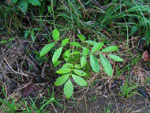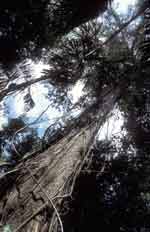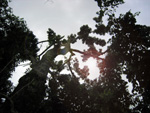Why is this species important?
Big-leafed mahogany is the most valuable and most extensively traded of the three American mahogany (Swietenia) species, and trade in the species is critical to local economies in the ‘range states’, countries where mahogany grows.
Where is it found?
Big-leaf mahogany grows in Mexico, the Central American countries of Belize, Costa Rica, El Salvador, Guatemala, Honduras, Nicaragua, and Panama and the South American countries of Bolivia, Brazil, Colombia, Ecuador, Peru, and Venezuela. The species has a wide geographical and ecological range, growing naturally in wet and dry tropical forests and on a variety of soil types.
How do people use it?
The wood is used to make furniture, paneling, lumber, and musical instruments.
Why is it threatened?
Over-harvesting
Mahogany is threatened by over-harvesting for commercial trade, with more than 120,000 m3 of big-leafed mahogany exported from Latin America each year. The majority of mahogany entering into international trade is from unmanaged natural forests. As one of the most precious of tropical hardwoods, the high prices mahogany fetches pay for the construction of roads into areas where commercial logging would otherwise be untenable.
Illegal logging
The high value of the timber also leads to illegal logging, inside forest concessions and outside, in parks and indigenous people’s reserves. Once roads are built, the forest is vulnerable to further exploitation and clearance for agriculture. Although most mahogany-producing countries do have laws and regulations in place to support sustainable forest management, and some have specific regulations for mahogany, many countries encounter difficulties in enforcing the regulations that have been developed.
Lack of Regeneration
There is some indication that mahogany is not successfully regenerating following commercial harvest. Mahogany is predominantly harvested by ‘selective logging’, in which only high value trees are extracted from the forest. This practice does not create the light conditions that seem to be necessary for mahogany regeneration and removes the majority of the seed producing trees, reducing the chances of seedling establishment. Commercial extinction of this species, logging to the point where the species is so sparely represented in the forest that it becomes uneconomic to harvest it, would be devastating for the species, for the local communities dependant upon the income from the harvest, and would undermine efforts to establish a permanent forest estate, areas designated for long term, sustainable timber harvest.
What conservation action is needed?
Big-leaf mahogany has recently been included in Appendix II of CITES (The United Nations Convention on International Trade in Endangered Species of Wild Fauna and Flora), meaning that any export operation requires an export permit, and the permit will only be granted if a Scientific Authority of the State has advised that the export is not detrimental to the survival of the species and a Management Authority of the State is satisfied that the specimen was not obtained illegally.
The extent to which the authorities of the range states have been able to successfully implement the requirements of Appendix II varies. In part, the problem of implementation results from the lack of an international standard for sustainable mahogany management and the lack of a system for ‘non-detriment findings’ (NDFs). Guidance for making a mahogany NDF is currently being developed by the World Conservation Union (IUCN). In the interim, many countries have voluntarily established export quotas and imposed cutting restrictions, such as the definition of a minimum cutting diameter.
Individuals can support mahogany conservation by only buying mahogany products from certified forests, such as those products that carry the Forest Stewardship Council (FSC) trademark.
Selected References:
Brown, N., Jennings, S. and Clements, T. (2003) The ecology, silviculture and biogeography of mahogany (Swietenia macrophylla): a critical review of the evidence. Perspectives in Plant ecology, evolution and systematics. Vol. 6/1,2: 37-49.
Grogan, J., Barreto, P., Verissimo, A. (2002) Mahogany in the Brazilian Amazon: Ecology and Perspectives on Management. Imazon. Belem.
Grogan, J. (2002) Some simple management guidelines could help the sustainable management of bigleaf mahogany in the neotropics. Tropical Forest Update ITTO 12(4)
ITTO (2002) Forestry certification: pending challenges for tropical timber. ITTO Technical Series No. 19
Lugo, A.E., Colon, J.F. & Alayon, M. (eds.) (2002) Big-leaf mahogany. Genetics, ecology and management. Ecological Studies Vol. 159. Springer-Verlag, New York
Mayhew, J.E., Newton, A.C. 1998. The silviculture of mahogany. CABI Publishing, New York.
Newton, A.C. (1996) The sustainability of uses of trees. Report to IUCN. A contribution to the WCMC/SSC Conservation and Sustainable Mangement of Trees project.
Robbins, C.S. (2000) Mahogany matters: the US market for big-leafed mahogany and its implications for the conservation of the species. TRAFFIC North America. Washington, D.C., USA.
Rosser, A. and Haywood, M. (2002) Guidance for CITES Scientific Authorities. Checklist to assist in making findings for Appendix II export. IUCN Species Survival Commission Occasional Paper No. 27. IUCN, Gland, Switzerland and Cambridge, UK.
Snook, L.K. (1996) Catastrophic disturbance, logging and the ecology of mahogany (Swietenia macrophylla King): Grounds for listing a major tropical timber species on CITES. Botanical Journal of the Linnean Society 122(1): 35-46.
Snook L. K. (1998) Sustaining harvests of mahogany (swietenia macrophylla King) from Mexico’s Yucatan forests: past, present and future. In Timber, tourists and temples. Conservation and development in the Maya Forest of Belize, Guatemala and Mexico. Ed. by R.B. Primack, D. Bray, H. A. Galletti and I. Ponciano. Pp. 61-80. Island Press, Washington.
TRAFFIC (2002) CITES Appendix III Implementation for Big-leaved Mahogany Swietenia macrophylla. TRAFFIC Online Report Series No. 1. TRAFFIC International, Cambridge, UK.
Veríssimo, A., Barreto, P., Tarifa, R. & Uhl, C. 1995. Extraction of a high-value natural resource from Amazonia: The case of mahogany. Forest Ecology and Management, 72: 39-60.
WWF (2002) CITES Appendix II listing and FSC certification: complementary strategies for conservation and sustainable management of timber species? A WWF Discussion Paper. WWF International Species Programme, Godalming, UK |
 |



|